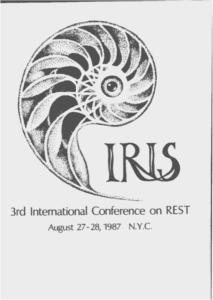This year marks the 70th anniversary of the invention of the world’s first float tank in 1954. From its early days as an experimental practice to its current status as a mainstream wellness activity, floating has undergone significant transformations.
As we reflect on the past seven decades, let’s explore the high-level eras and milestones that have shaped the history of float tanks.
The Early Years (1950s to 1960s)
In 1954, Dr. John C. Lilly constructed the first isolation tank at the National Institute of Mental Health (NIMH), initiating the story of floating. Curious about the effects of sensory deprivation on the brain, Lilly’s experiments challenged conventional wisdom. His experiences in the tank revealed a profound sense of relaxation and well-being, sparking further developments.
 Many theories circulated about what would happen if you deprived the brain of external stimuli. Would it lead to sensory trauma? Psychosis or hallucinations?Rather than any kind of trauma, he reported feeling a profound serenity and physical relaxation. The lack of distraction didn’t derange his mind – it unlocked access to higher states of awareness unlike anything he’d known. His first prolonged floats suggested sensory isolation didn’t inherently deprive the brain at all. In fact, it seemed like it might have the potential to make us more conscious, rather than less.
Many theories circulated about what would happen if you deprived the brain of external stimuli. Would it lead to sensory trauma? Psychosis or hallucinations?Rather than any kind of trauma, he reported feeling a profound serenity and physical relaxation. The lack of distraction didn’t derange his mind – it unlocked access to higher states of awareness unlike anything he’d known. His first prolonged floats suggested sensory isolation didn’t inherently deprive the brain at all. In fact, it seemed like it might have the potential to make us more conscious, rather than less.
At NIMH, his colleague Dr. Jay Shurley also extensively studied himself and others in the tanks. Their work firmly established flotation’s merits within the scientific community. Beyond those directly involved in the research, however, few were aware of these strange “sensory deprivation” devices.
Over the coming years this would change dramatically as word spread both about Dr. Lilly’s research and the remarkable states it could produce. In the late 60s, Lilly published Programming and Metaprogramming in the Human Biocomputer, which would become a cult-classic highlighting his early floatation experiments. He also started teaching workshops on floatation in California, and the stage was being set for an era where tanks would make the leap into the public realm.
Tanks Go Commercial – 1970s
Commercial float tanks emerged in the 1970s when Glenn Perry collaborated with Lilly to modify the tank’s design. They formed the first commercial float tank manufacturing company, Samadhi Tank Co., and opened the first commercial float center in 1979. This marked the official beginning of the float industry.
In 1973, along with Glenn’s wife Lee, they formed the first commercial float tank manufacturing company, Samadhi Tank Co., which is still producing tanks 50 years later. For the first time, regular folks could easily purchase and install these exotic devices in their homes.
Then, in 1979, Samadhi opened up the first commercial float center, which was located in Beverly Hills with 5 float tanks that customers could book time in. The business proved to be an immediate success, and between this and Samadhi’s manufacturing arm, the float industry had officially begun.
Rapid Growth – 1980s
The 1980s witnessed the rise of floating, with increased public awareness and scientific interest. Float centers proliferated, and research explored the benefits of floating on various aspects of health. Conferences like those hosted by the Float Tank Association (FTA) provided platforms for sharing ideas and research.
Articles in major outlets like Rolling Stone explored this strange new practice. Within another year, another 5 centers had opened their doors, and that was just the beginning as more and more centers continued popping up in cities across North America to meet the growing demand.
The field also began attracting serious scientific interest. Researchers such as Tom Fine and Dr. John Turner studied floating’s effects on everything from high blood pressure to athletic performance. Major universities were supplying their labs with dedicated float tanks for experiments, and for the first time rigorous evidence was collected on the many benefits of floating.
Conferences like those hosted by the Float Tank Association (FTA) and the International REST Investigators Society (IRIS) provided a hub to share ideas and new research. The evidence was clear – floating had significant impacts on both mind and body.
By the mid-1980s, there were commercial float centers worldwide. What had seemed like a fringe practice was transitioning into a legitimate health and wellness industry with proven benefits.
The Sudden Fall of Floating – Late 80s and 90s
The AIDS epidemic in the late 80s led to a sudden decline in floating’s popularity due to unfounded fears around communal water. The Western market collapsed, causing a setback that took two decades to recover from. However, strong floating communities persisted in the UK, Europe, and the Nordic countries.
Persistence and Growth – 2000s
The new millennium saw a resurgence of floating with new research and endorsements from figures like Joe Rogan. Commercial centers and manufacturers began to reemerge, signaling a gradual return of floating in the Western world.
 However, that was soon to change as new research continued to come out abroad and a very popular and very vocal Joe Rogan began regular endorsement of float tanks. In the late 2000s, for the first time in a long while, new commercial centers were beginning to open up, and new manufacturers were beginning to produce float tanks.
However, that was soon to change as new research continued to come out abroad and a very popular and very vocal Joe Rogan began regular endorsement of float tanks. In the late 2000s, for the first time in a long while, new commercial centers were beginning to open up, and new manufacturers were beginning to produce float tanks.
Resurgence – 2010s
The 2010s witnessed an explosion in the number of float tank centers in the United States, coupled with technological advancements and increased research funding. Celebrity endorsements and media portrayals in popular shows contributed to floating becoming a global wellness movement.

Float research (much of which we’ve covered in previous blog posts) began to receive funding and attention again, and some of the most advanced floatation therapy labs were constructed, such as the Float Lab at the Laureate Institute for Brain Research (LIBR). With more funding and participants than ever before, the research during these recent years has demonstrated the benefits of floating, both mental and physical, time and time again.
More celebrity endorsements also began rolling in from professional athletes and floating got prominent screen time in popular shows like Stranger Things and The Big Bang Theory. By the mid 2010s, what had begun decades prior as a peculiar science experiment had blossomed into a thriving global wellness movement.
What Does The Future Hold?
As we celebrate the rich history of floating, the future holds boundless potential. With ongoing innovations, applications, and discoveries, the global wellness movement initiated by floating continues to evolve. The journey that began as a peculiar science experiment has blossomed into a thriving industry, and the future promises even more exciting developments.
Here’s to another 70 years of floating and the wellness journeys it continues to inspire!





Recent Comments